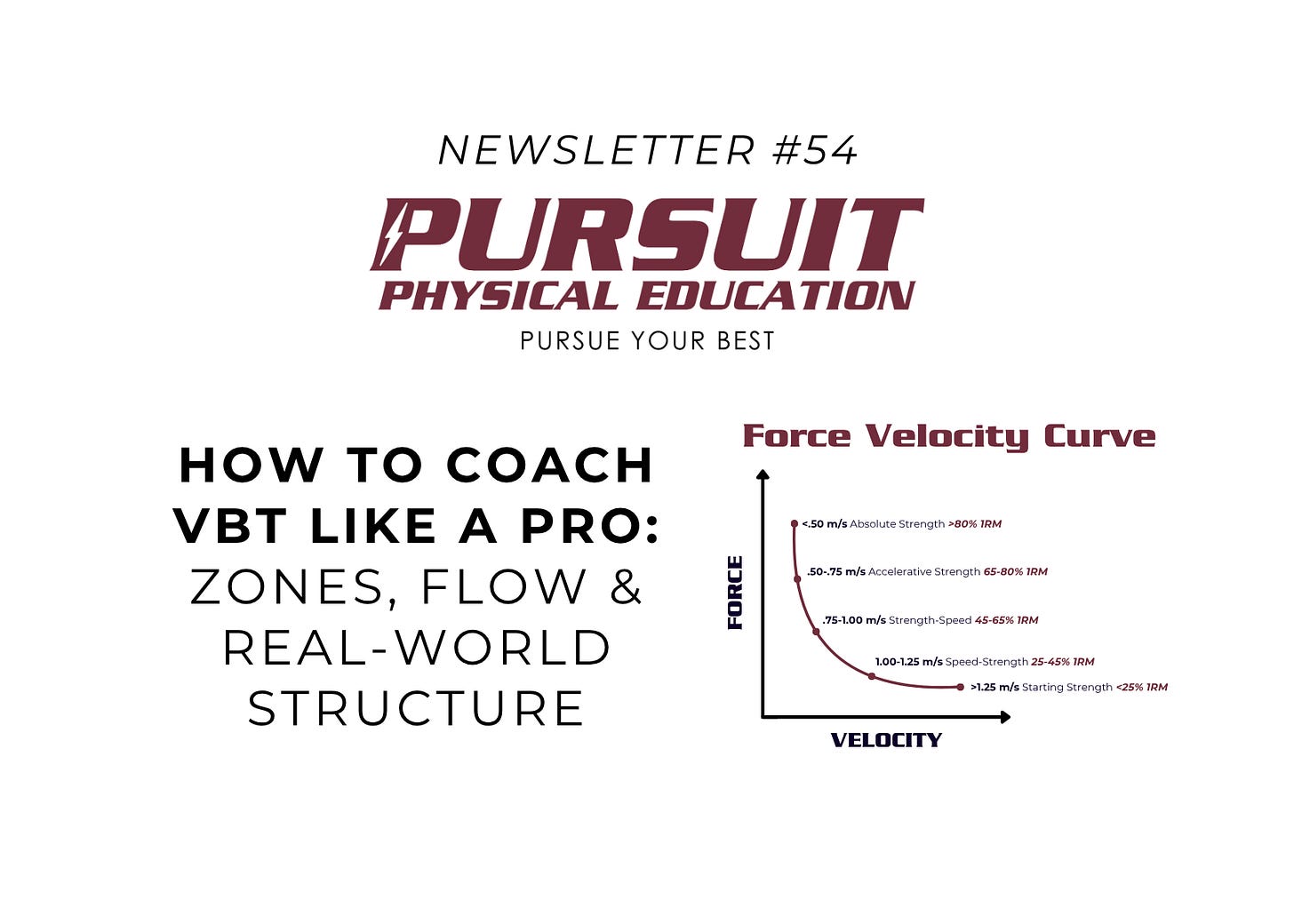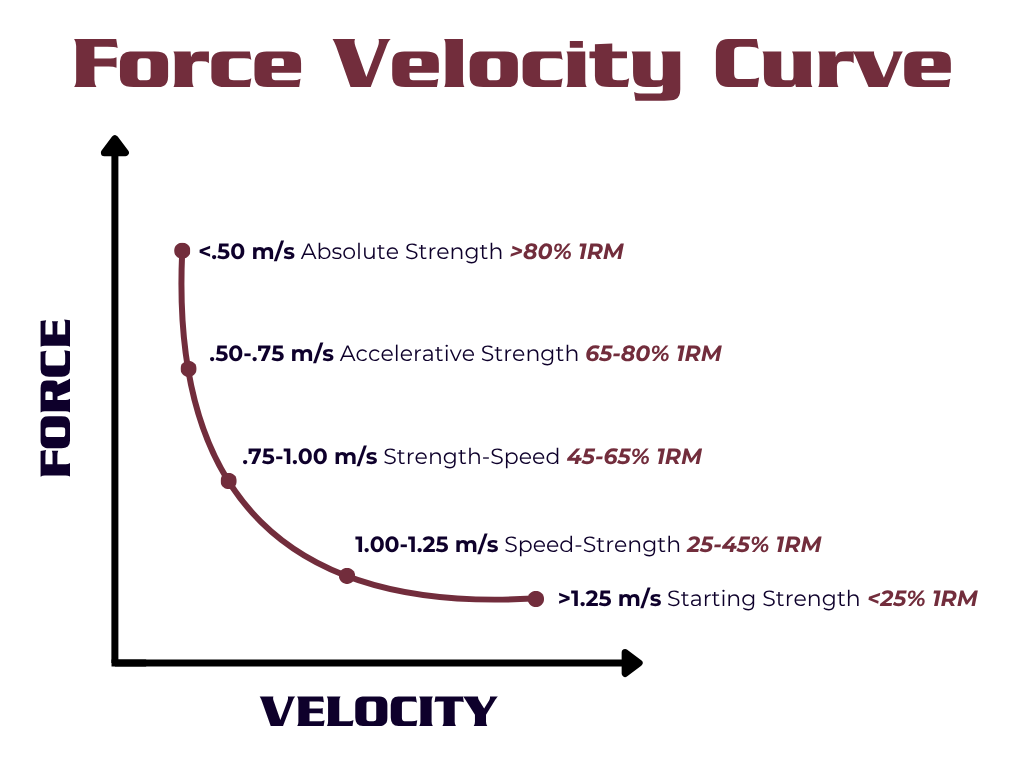How to Coach VBT Like a Pro: Zones, Flow & Real-World Structure
#54 - Strength & Speed Coaching - Pursuing Your Best ⚡️
Velocity-Based Training (VBT) can seem overwhelming at first.
What zones should I use?
How do I keep the session moving?
Do I need to adjust every set?
Let’s simplify it.
This week, we’re walking through the practical framework we use in class:
What zones we use (and why)
How we blend rep ranges with bar speed
When to adjust—and when not to
What a typical VBT session actually looks like
You don’t need to overcomplicate it. But you do need a structure.
Here’s how we build ours. Buckle up, I put a lot in this one…
The Zones We Use
VBT works best when you define your intent by movement speed—not just weight.
Here are the five primary zones we coach in our Strength & Speed class:
We rarely go below 0.3 m/s.
Why? Because grinders don’t help us move better or play faster.
We don’t chase fatigue. We chase transfer.
Mean vs. Peak Velocity: What’s the Difference?
When using Velocity-Based Training (VBT), bar speed is typically measured in one of two ways:
Mean Velocity: The average speed of the bar through the entire concentric (lifting) phase.
Peak Velocity: The single fastest point recorded during the lift.
Both are useful, but they’re not interchangeable.
Use Mean Velocity when:
Training strength-focused movements like squats, deadlifts, presses, and rows
Coaching intent over the entire rep, not just the burst
You want more stable, reliable numbers for autoregulation
Use Peak Velocity when:
Coaching Olympic lifts or explosive throws and jumps
The focus is on max effort in a short window
You want to assess true explosiveness and bar speed
For most school-based Strength & Speed programs, Mean Velocity is the better default.
It’s more consistent.
It’s less sensitive to bar whip or device variability.
And it reflects total intent—not just the fastest millisecond.
Blending VBT and Rep Ranges
Here’s the big question coaches ask:
Do you still give rep ranges when using VBT?
Yes—but with a twist.
We treat reps as a starting point and bar speed as the gatekeeper.
Example:
If the goal is 3–5 reps in the .60-.70 m/s range, we let athletes continue as long as their bar speed stays within range.
As soon as they dip out of zone for two reps in a row (or the final rep drops below the cutoff), they shut it down.
This keeps intensity high and junk volume low.
When to Adjust: Cutoffs, Feedback & Flow
Here’s how we coach adjustments mid-session:
Too fast? Encourage an increase (if quality allows).
Too slow? Re-assess bar path, setup, or reduce the load.
In the zone? Stay there. Let them feel it.
Coach Adam Vogel (Homewood-Flossmoor High School) has a pretty simple adjustment chart that I love.
Every .01 equates to at least 1 lb.
For example, if someone is .05 below the target then they need to at least take off 5 lbs. The opposite is true too, if someone is faster than the threshold then they can add weight.
The goal is to build awareness and make better training choices, not just data.
A Real-World VBT Session: Start to Finish
Here’s a quick look at how we flow through a session with 30+ athletes and only 42 minutes:
1. Movement Prep (8–10 min)
Dynamic warm-up, kickstarter, + explosive prep
(E.g. jumps, med ball throws, movement-specific activation)
2. VBT Main Lift (10-12 min)
Target one key lift (split squat, trap bar or sumo deadlift, or Olympic variation)
Assign a goal zone
Use rep ranges as guidelines (we use APRE), but coach to the zone
Each athlete gets immediate feedback from the encoder
3. Accessory Strength (10–18 min)
We shift to traditional loading here—still with explosive intent
Example: rows, hamstring work, core, etc
Sometimes we might add in VBT just to compete a little
4. Extra Work & Recovery Options (4-6 min)
Depending on the day and time of year
Our goal is to have everyone move with purpose.
Encoders primarily stay with the main lift and and then sometimes used later on in the workout.
VBT Cheat Sheet: Sample Velocities by Movement
While every athlete moves differently, we use general bar speed targets to guide intent across our main lifts. For example:
Trap Bar or Sumo Deadlift / Split Squat
Strength Range: 0.45–0.60 m/s
Power Range: 0.70+ m/s
Olympic Lifts (e.g. Hang Clean)
Explosive Range: 1.00+ m/s
These aren’t rigid rules—they’re teaching tools.
They help athletes understand what the right effort feels like and give athletes and coaches clear reference points to adjust in real time.
How We Progress Velocity Cutoffs Week-to-Week
Inside each velocity zone, we adjust the cutoff speed weekly to drive intent and progression.
Here’s how it might look across a 4-week block when training in the 0.50–0.75 m/s range:
Week 1: Cutoff = 0.65 m/s
Week 2: Cutoff = 0.60 m/s
Week 3: Cutoff = 0.55 m/s
Week 4: Cutoff = 0.50 m/s
This method encourages speed-first movement early in the cycle, then allows load to climb without sacrificing intent.
After four weeks, we’ll reset the cycle—often progressing the movement variation, shifting rep ranges, or changing the primary training focus for the next block.
What’s the biggest challenge in your program right now?
Reply and tell me.
If I can help, I will. If not, I’ll point you toward someone or something that can.
No pressure. Just trying to move this profession forward, one coach at a time.
Final Thoughts
VBT isn’t about chasing numbers. It’s about creating a system that reflects reality.
One where movement matters.
Where effort is coached.
And where progress is visible.
You don’t need to overhaul your entire program. Just start with one lift, one zone, one goal.
Build it with intent—and you’ll be surprised how quickly your kids learn to coach themselves.
Next: How we introduce VBT to athletes and build confidence from day one.
Until then—keep pursuing excellence.
— Preston ⚡️
🔒 Paid Subscriber Benefit
Thanks for supporting Pursuit PE. You’re not just here for ideas—you’re here for support that actually moves the needle.
This Week’s Benefit:
🎥 Ask Me Anything & Get a Personal Video Response
Have a coaching challenge?
Need feedback on your training split, VBT setup, or classroom structure?
Send your question my way—and I’ll reply with a personalized video breaking it down. Think of it like a mini consulting session, built specifically for your situation, your program, and your athletes.
Please see details below…
Not a paid subscriber yet?
Upgrade today to unlock exclusive resources—and get access to support that actually supports you.






